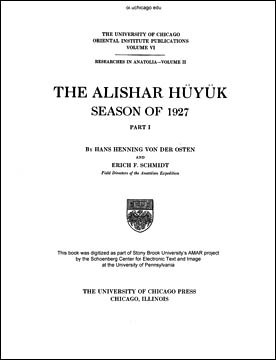OIP 6. Researches in Anatolia 2. The Alishar Hüyük Season of 1927, Part 1 Hans Henning von der Osten and Erich F. Schmidt

In the early twentieth century, the plans of the Oriental Institute for the investigation of Hittite civilization involved three distinct lines of research: (1) exploration, (2) survey, and (3) excavation. The explorations project, as laid out by von der Osten, comprised a large region in north central Turkey just east of Ankara. In carrying out these explorations, von der Osten laid down on his maps some three hundred new sites, varying from large to small, most of them entirely unknown to scholars heretofore.
For the elucidation of the sequence of cultural stages of the Hittite regions, lying as a stratified record in the mounds of Asia Minor and determinable especially by the pottery, it was necessary to find a site where such stratified evidence had never been disturbed by excavation. A mound about 128 miles southeast of Ankara seemed of sufficient size to insure its importance and sufficiently far from Boghazköy to make possible some degree of political independence. As it lay near the village of Alishar, that name was attached by the expedition to the mound.
The present volume is the first report on the excavation of Alishar Hüyük. The work began under the leadership of von der Osten in 1927, continuing under the joint control of von der Osten and Erich F. Schmidt in the summer of 1928, and then under the sole control of Dr. Schmidt.
This book was digitized as part of Stony Brook University's AMAR project by the Schoenberg Center for Electronic Text and Image at the University of Pennsylvania.
- Oriental Institute Publications 6
- Chicago: The University of Chicago Press, 1930
- Pp. xii + 284; 251 figures, 5 plates
- Out of Print

